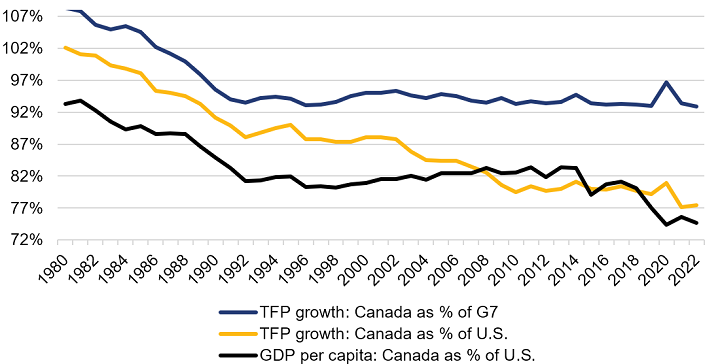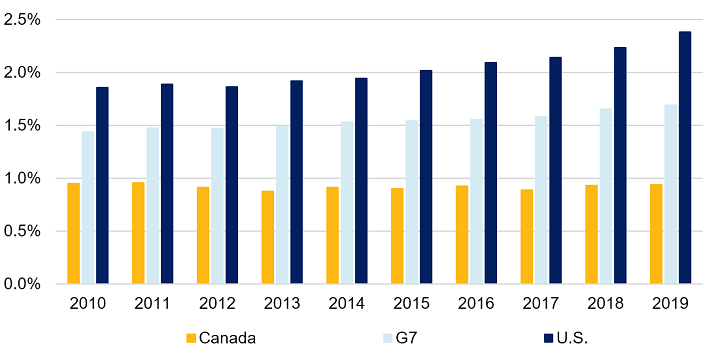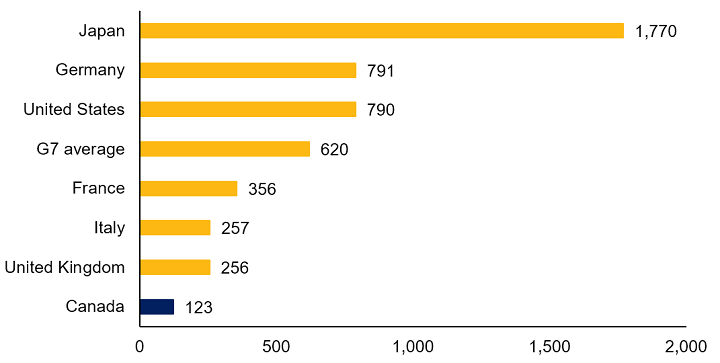Economists view productivity growth as the main long-term determinant of improvements in the average standard of living, as measured by the growth in gross domestic product (GDP) per capita. Researchers and policy makers note that a decline in productivity growth over the past few decades is one of Canada’s most important economic challenges. This decline is a concern for parliamentarians and the federal government because, if it is not reversed, Canadians’ average standard of living will grow less rapidly, if not decline, in the future.
The aim of this publication is to explain what productivity growth is and why it matters for improving Canada’s average standard of living. It explores the importance of “new ideas” – a concept coined by the Nobel Laureate Paul M. Romer – in determining Canada’s long-term productivity growth and emphasizes that the long term growth of an advanced economy like Canada depends largely on the extent to which new ideas are generated and those ideas become innovations that increase productivity. The basic insight emerging from the economic literature is that the long run growth rate of an advanced economy is primarily the product of the number of researchers, entrepreneurs and scientists and their respective productivity.
Recent research suggests that significant, ground-breaking ideas are becoming more difficult to find and that investments in research and development need to be significantly enhanced in Canada and globally in order to continue to find those ideas.
The Canadian economy has been facing a continuous decline in productivity growth over the past four decades. Indeed, this has emerged as one of Canada’s most enduring economic challenges and a significant concern for parliamentarians and the federal government.
The Standing Senate Committee on Banking, Commerce and the Economy, for example, has taken up the issue and tabled three reports on business investment and productivity since 2018.1 Moreover, in Budget 2022, the federal government recognized that if Canadian businesses continue to underinvest in innovation and in research and development (R&D) compared to their foreign counterparts, Canada will experience the lowest per capita gross domestic product (GDP) growth among Organisation for Economic Co operation and Development (OECD) countries from 2020 to 2060.2
Productivity, or what economists call total factor productivity (TFP), is a measure of economic performance that compares the amount of goods and services produced (output) with the amount of labour and capital (inputs) used in producing those goods and services.3 Growth in productivity occurs when the output increases more rapidly than labour and capital inputs. Productivity growth serves as the primary means whereby economic growth can surpass what could be achieved solely by increasing labour and capital inputs. According to Statistics Canada, around 90% of the growth in Canada’s per capita output over the past 40 years can be attributed to productivity growth.4
Productivity growth tends to generate not only higher earnings for workers and higher profits for businesses, but also additional government revenues. These economic advantages hold the promise of enhancing the standard of living of Canadians through a combination of higher income, increased leisure time, and increased government services and transfers. In addition to improving the standard of living, productivity growth can lower inflation by reducing the gap between aggregate demand and the economy’s capacity to supply goods and services.
Part 2 of this publication presents data on the growth rate of productivity and GDP per capita in Canada and compares it with that in the United States (U.S.) and the average among the Group of Seven (G7) countries. Part 3 discusses the crucial role of new ideas in determining long-term productivity growth. Part 4 provides some potential reasons for Canada’s lower productivity growth viewed through the lens of the generation of new ideas.
Figure 1 shows that between 1980 and 2022, Canada’s productivity growth rate decreased from 102% to 77% of the rate of the U.S., and from 108% to 93% of the average rate of the G7.
It also illustrates that this relative decline in productivity growth mirrors the relative decline in Canada’s average standard of living compared to its main trading partner, the U.S. Between 1980 and 2022, Canada’s average standard of living – as measured by GDP per capita – decreased from 93% to 75% of the U.S. rate. In 2022, Canada’s GDP per capita was US$57,000 (C$77,720), while GDP per capita in the U.S. was US$76,400 (C$104,171).5
Figure 1 – Total Factor Productivity (TFP) Growth, Canada as a Percentage of United States (U.S.) and of G7 Average, and Gross Domestic Product (GDP) per Capita, Canada as a Percentage of U.S.

Sources: Figure prepared by the Library of Parliament using data on TFP growth and GDP per capita obtained from Banque de France, “Long-Term Productivity Database,” Database, accessed 23 October 2023, and Organisation for Economic Co-operation and Development, “Level of GDP per capita and productivity,” Database, 23 October 2023.
Given the importance of productivity to societal welfare, it is crucial to understand what determines the productivity growth rate over time. This is the question that Paul M. Romer, 2018 Nobel Laureate in Economics,6 sought to address in a 1990 paper.7
In that paper, Mr. Romer introduced a distinction between two fundamental concepts to help better understand productivity growth: “ideas” and “objects.” The latter include all the usual things that are considered in economics and everyday life, such as money, work, skills, land, roads, specific professions, commodities such as oil and soybeans, and even measurable environmental goods like clean water.
What sets ideas apart from objects is that the latter exhibit rivalry. That is, the use of an object by one person prevents its concurrent use by others. Take, for instance, the number of individuals driving on highways, using computers, seeking the expertise of specific doctors or drinking water. As the number of individuals using these objects increases, the availability of these objects decreases. This competition forms the foundation of scarcity, a fundamental concept in economics that highlights the basic reality that both human and nonhuman resources are limited and that, even with the most advanced technical knowledge, it is only possible to generate a finite quantity of each economic good or service. For example, one person is more productive with a computer, but making thousands of people similarly more productive would require thousands of computers.
Conversely, ideas possess a unique quality known as nonrivalry, or what has been described as infinite usability.8 That is, any number of individuals can use an idea at the same time. An idea could be a conceptual framework, a design or a blueprint for doing something. In essence, it is a set of instructions for using existing objects in a way that increases output. Examples include things like calculus, the design of the latest advanced quantum computer, the code that turns someone’s typing into letters on a computer screen, new management styles, the recipe for a new antibiotic, or the latest COVID-19 vaccine, which has protected the health of billions of people.
The fact that many individuals can use an idea at the same time suggests that a country’s average standard of living depends on the cumulative pool of ideas rather than the number of ideas per person. This is a notable distinction from objects such as capital. While each computer enhances the productivity of a single worker, a ground-breaking idea – like a COVID-19 vaccine – can elevate the productivity of countless workers without the need for a proportional increase in the number of ideas. Thus, what really drives long-term economic growth in advanced economies like Canada is the total number of ideas generated over time and turning those ideas into innovations that increase productivity.
With regard to the origin of new ideas, economic research suggests that new ideas come from the ingenuity of individuals, particularly researchers, entrepreneurs and scientists.9 Therefore, the long-term progression of a country’s standard of living depends on the rate at which its population produces new ideas that increase productivity.
From the perspective of the importance of new ideas, how can we explain the decline of productivity growth in advanced economies, including Canada, over the past few decades? One possible explanation for this decline is that the growth rate of people searching for new ideas appears to have slowed.10
Charles I. Jones conducted a growth accounting exercise for the U.S. and found that 80% of the 2% annual growth in GDP per person in the U.S. since 1950 is accounted for by increases in the fraction of the population devoted to R&D, rising educational attainment and declines in misallocation of resources, including human capital.11 The remaining 20% comes from population growth. Interestingly, he estimated that the contribution of the physical capital-output ratio to U.S. economic growth over this long period of time was zero.
Research has attributed the decline in the productivity growth of advanced economies in recent decades to the fact that “new ideas” are getting more difficult to find.12 That is, “research effort is rising substantially while research productivity is declining sharply.” Strong and consistent evidence has been found for a widespread decline in research productivity across various domains and in almost every sector studied. Using the overall U.S. figures as a benchmark, research productivity undergoes a 50% drop every 13 years, indicating an increasing challenge in generating new ideas. To maintain consistent growth in GDP per capita, the U.S. would need to double its research efforts every 13 years to counteract the growing difficulty of discovering new ideas.
Figure 2 compares the research efforts of Canada with those of the U.S. and the G7 as measured by their business enterprise R&D expenditures as a percentage of GDP. Over the 2010 to 2019 period, Canada’s total business enterprise R&D expenditures as a percentage of GDP remained approximately the same and averaged less than half of that of the U.S. Meanwhile, the U.S. and the G7 (on average) both increased their total business enterprise R&D expenditures as a percentage of GDP.
Figure 2 – Total Business Enterprise Research and Development Expenditures in Canada, United States (U.S.) and G7 between 2010 and 2019 (% of Gross Domestic Product)

Source: Figure prepared by the Library of Parliament using data obtained from Organisation for Economic Co-operation and Development, “Main Science and Technology Indicators,” Database, accessed 23 October 2023.
In economics, there is a long-standing practice of measuring the generation of new ideas through the analysis of patents.13 Figure 3 shows that Canada had the smallest number of resident patent applications per million inhabitants among the G7 in 2021, a pattern observed over several years.
Figure 3 – Resident Patent Applications per Million Inhabitants, G7 Countries, 2021

Source: Figure prepared by the Library of Parliament using data obtained from World Intellectual Property Organization, “Intellectual Property Fact Sheet 2022,” ![]() (169 KB, 2 pages) Statistics Data Center, Database, accessed 23 October 2023.
(169 KB, 2 pages) Statistics Data Center, Database, accessed 23 October 2023.
Lastly, improving workplace diversity and leveraging artificial intelligence could also help to improve Canada’s long-term productivity growth.
There is strong evidence that embracing diversity in the workplace can not only foster a rich mix of perspectives but also potentially drive innovation by bringing together a variety of ideas and approaches, ultimately contributing to increased productivity. For example, an influential 2019 paper on economic growth documents the fact that 94% of doctors and lawyers in the U.S. were white men in the 1960s. By 2008, this proportion had dropped to 62%.14 Given that “innate talent” for highly skilled professions is expected to be similar across all groups, the study’s authors found that the job distribution in the 1960s implies that many innately talented African Americans and women were not in occupations aligned with their skill sets. The study quantifies the broader economic impact of this shift between 1960 and 2008, revealing that 15% to 20% of the growth in aggregate GDP per capita in the U.S. can be attributed to a more efficient allocation of talent. Discrimination, unconscious bias, racism, gender roles, gender-based stereotypes, non-gender-sensitive or family-unfriendly workplaces, insufficient parental leave and inflexible work hours are among the factors that hindered the efficient employment of talented individuals other than white men during that period. These findings suggest that Canada could also improve its productivity growth by further embracing diversity in the workplace.
With respect to artificial intelligence, although it is still in its infancy in many areas, it may help to increase Canada’s productivity growth in the future by enhancing Canadians’ ability to generate new ideas and innovate.15
Productivity growth is the main driver of a country’s standard of living. Unless Canada’s prolonged decline in productivity growth is reversed, Canadians’ average standard of living will grow less rapidly, if not decline, in the future.
Economic research emphasizes the crucial role of new ideas in determining long-term productivity growth. It also suggests that the discovery of significant, ground-breaking ideas has become increasingly challenging, directly influencing innovation and productivity growth. This underscores the need for a substantial increase in Canada’s research efforts to discover, develop and commercialize new big ideas.
© Library of Parliament